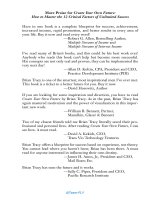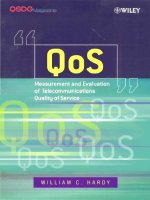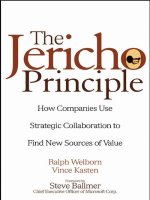John Wiley & Sons - Essentials Of Intellectual Property
Bạn đang xem bản rút gọn của tài liệu. Xem và tải ngay bản đầy đủ của tài liệu tại đây (4.69 MB, 287 trang )
ESSENTIALS
of Intellectual Property
Essentials Series
To keep up with rapid business changes, professionals today need to get
up to speed quickly with reliable and clear information. Wiley’s
Essentials series introduces the first concise guidelines to key topics in finance, accounting, performance improvement, operations, technology,
and information management. These books provide in-depth coverage;
tips; techniques; and illustrative real-world examples, exhibits, and best
practices. The Wiley Essentials series—because the business world is always changing . . . and so should you.
Other books in the series include:
Essentials of Accounts Payable
Essentials of Capacity Management
Essentials of Cash Flow
Essentials of Corporate Performance Management
Essentials of Credit, Collection, and Accounts Receivable
Essentials of CRM:A Guide to Customer Relationship Management
Essentials of Trademarks and Unfair Competition
Essentials of XBRL
For more information and to receive periodic e-mail notices regarding
forthcoming publications, please visit us at www.wiley.com.
ii
ESSENTIALS
of Intellectual Property
Alexander Poltorak
and
Paul Lerner
JOHN WILEY & SONS, INC.
Copyright © 2002 by John Wiley & Sons, Inc., New York. All rights reserved.
No part of this publication may be reproduced, stored in a retrieval system or
transmitted in any form or by any means, electronic, mechanical, photocopying,
recording, scanning or otherwise, except as permitted under Sections 107 or 108
of the 1976 United States Copyright Act, without either the prior written
permission of the Publisher, or authorization through payment of the appropriate
per-copy fee to the Copyright Clearance Center, 222 Rosewood Drive, Danvers,
MA 01923, (978) 750-8400, fax (978) 750-4744. Requests to the Publisher for
permission should be addressed to the Permissions Department, John Wiley &
Sons, Inc., 605 Third Avenue, New York, NY 10158-0012, (212) 850-6011, fax
(212) 850-6008, E-Mail:
This publication is designed to provide accurate and authoritative information in
regard to the subject matter covered. It is sold with the understanding that the
publisher is not engaged in rendering legal, accounting, or other professional services. If legal advice or other expert assistance is required, the services of a competent professional person should be sought.
This title is also available in print as ISBN 0-471-20942-2. Some content that
appears in the print version of this book may not be available in this electronic
edition.
For more information about Wiley products, visit our web site at
www.Wiley.com.
About the Authors
Alexander I. Poltorak is the founder and chief executive officer of
General Patent Corporation (GPC), an intellectual property (IP) management company focusing on IP strategy, patent licensing and enforcement,
international technology transfer, and IP portfolio management. Prior to
establishing GPC in 1989, Dr. Poltorak was the president of Poltorak
Associates Inc., a management consulting and patent licensing firm, which
he formed in 1987. Before that, he was chief executive officer of Rapitech
Systems, Inc., a computer company that he co-founded in 1983. Prior to
Rapitech, Dr. Poltorak served as Assistant Professor of Biomathematics at
the Neurology Department of Cornell University Medical College,
where he conducted research in image processing and computer tomography. He also served as Assistant Professor of Physics at Touro College.
Dr. Poltorak has published several papers in scientific journals.
Dr. Poltorak emigrated from the former USSR in 1982, where he
was awarded a doctorate in physics at the age of 22 for a significant
breakthrough in Einstein’s Theory of Relativity. As a political dissident,
he was later stripped of his degrees for anticommunist activities. He is a
member of the Licensing Executives Society (LES), the Association of
University Technology Managers (AUTM), Intellectual Property
Owners Association (IPO), the National Association of Corporate
Directors, the New York Academy of Science, and the American
Physical Society. He was a U.S. co-chairman for the Subcommittee on
Information Exchange of the US-USSR Trade and Economic Counsel.
He is on the advisory board of Patent Strategy & Management, for which
he co-wrote “Corporate Officers and Directors Can Be Liable for
v
ESSENTIALS of Intellectual Proper ty
Mismanaging Intellectual Property.” The article appeared in its May and
June 2000 issues. He is co-author with Paul Lerner of an article about
Grain Processing v. American Maize Products, “Grain, Grain, Go Away,”
which examines recent major developments in patent infringement
damages. The article appeared in the February 2000 edition of
Intellectual Property Worldwide.
Paul J. Lerner is the Senior Vice President and General Counsel of
General Patent Corporation (GPC). Before joining GPC, Mr. Lerner
was a partner in the Hartford, Connecticut, business law firm of Pepe &
Hazard LLP. He has led IP law departments at Olin Corporation, Black
& Decker Corporation, and multinational electrical construction giant
Asea Brown Boveri, Inc.
Prior to embarking on a law career, Mr. Lerner was a project manager at the Illinois Institute of Technology Research Institute in
Chicago, where he managed a technology transfer and technology forecasting team. Mr. Lerner’s education includes a BS in Aeronautical
Engineering from Purdue University, an MBA from Loyola University,
a JD from DePaul University, and postgraduate legal studies at John
Marshall College of Law. He is an Adjunct Professor of IP law at the
University of New Haven.
Mr. Lerner is a member of the Licensing Executives Society (LES)
and the American Intellectual Property Law Association (AIPLA). He is
co-author with GPC’s chairman and CEO, Alexander Poltorak, of an article about Grain processing v. American Maize Products, “Grain, Grain,
Go Away.” He also co-wrote “Corporate Officers and Directors Can Be
Liable for Mismanaging Intellectual Property.” In September 2000, Mr.
Lerner’s article “Strategic Auditing: The Key to Minimizing Litigation
Bills” was published by corporateintelligence.com.
General Patent Corporation is based in Montebello Park, Suffern,
New York.
vi
Contents
Foreword
ix
Introduction: Setting the Stage
xxi
1
The Big Three: Patents, Trademarks, and Copyrights
2
The Supporting Players: Other Types of IP
37
3
Protecting the Fruits of Your R&D
51
4
Know What You Have (IP Audit) and What the Other Guy
Has (Competitive Intelligence)
59
5
What Is It Worth—Putting a Value on Intellectual Property
75
6
Make More Money by Sharing (Licensing)
89
7
Officers and Directors Beware—You Can Be Liable
for Mismanaging Intellectual Property
99
1
8
Enforcing Your Rights
111
9
Intellectual Property in Cyberspace
173
The Patent Portfolio and Its Effect on Stock Price
187
A
Trademark and Service Mark Application
193
B
Copyright Application
201
C
Confidentiality and Nondisclosure Agreement
205
D
Invention Assignment Form
207
E
Basic IP Audit Questionnaire
211
F
Patent Valuation
213
10
vii
ESSENTIALS of Intellectual Proper ty
G
Invention Disclosure Form
237
H
License Agreements
239
Bibliography
253
Further Reading
255
Index
257
viii
Foreword
s I write this, the U.S. Patent and Trademark Office has just released
its annual report of the top ten private sector organizations receiving patents in the prior year. A comparison of the listing for 2001
to those of past years reveals that the number of patents required to rank
first (as IBM has done since 1993) has more than tripled in the past
decade; the total number of U.S. patents issued annually has gone up
nearly sixty-five percent; and the proportion garnered by the top ten-all
well known electronics companies—has increased from seven and onehalf percent to nearly ten percent of all patents issued in 2001.
Fascinating statistics, but what’s behind them? Simply put, it’s money.
Dollars, Yen, Euros, billions of them collected in the form of royalties
every year by companies and individuals (the late Jerome Lemelson, for
example) with valuable intellectual property, principally patents. IBM
alone will have received nearly two billion dollars during 2001in IP-related payments, most of it cash, and nearly all of it pure profit. Canon,
Hitachi, Lucent and many other top patent holders enjoy significant returns on their R&D investments. And then there are the software companies, Oracle, Microsoft and, yes, IBM again, whose products are
intellectual property, protected globally by copyrights and earning billions in sales.
No wonder companies of all sizes throughout the world (eight of the
USPTO’s top ten are non-U.S. companies) are paying close attention to
acquiring and leveraging patents, copyrights, trademarks and other intellectual property.What was once the province of the patent department, all
A
ix
ESSENTIALS of Intellectual Proper ty
too often a corporate backwater, now has the full attention of most CFOs
and many CEOs. As IP is seldom taught outside of law schools, and then
only to those focused on this niche of jurisprudence, where can the business executive turn for a clear, concise and useful briefing on this new
phenomena? Most legal tomes cover in dreary prose, and at great length,
every aspect of IP law, but none of the exciting potential of their subject
matter. ESSENTIALS OF INTELLECTUAL PROPERTY, by
Alexander Poltorak and Paul Lerner, admirably fills this vacuum.
The authors — who are the principals of General Patent Corporation, an imaginative and successful intellectual property management
and licensing firm—not only know the subject matter, they explore the
nuances, and expose the pitfalls, in a thorough and refreshingly readable
fashion. They resort to plain English to guide us to a clear understanding of “the currency of the New Economy” by systematically explaining the essential legal elements and business value of each type of IP,
with useful suggestions of how to acquire, protect and deploy these fruits
of creativity.
It is well realized that most IP, particularly that held by corporations,
is undervalued and unappreciated. As IP is usually not reflected on the
balance sheet (there is currently a groundswell of proposals to change
this), it is widely ignored by those charged with providing a return on
investment, as represented by assets. On the other hand, the returns are
extremely generous once these valuable assets are recognized and tapped
for their potential. The authors provide comprehensive and useful insight and guidance for an effective process of protection, recognition,
valuation and exploitation of what a recent book on the subject referred
to as “Rembrandts in the Attic” (Kevin G. Rivette and David Kline,
Rembrandts in the Attic [Boston: Harvard School Press, 1999]).
A chapter addressing the prospect of liability to corporate executives
and directors for mismanaging intellectual property makes sobering
reading, and if nothing else will, should be a wake-up call to many who
x
Foreword
have approved large sums to acquire IP without having a clue of what
to do with it, and why. If this were not sufficient, the final chapter “The
Patent Portfolio And Its Effect On Stock Price” should arouse the most
somnolent of corporate custodians.
Poltorak and Lerner have provided a clear and useful road map for
the non-lawyer business executive, without stinting on necessary detail,
and surprisingly for the genre, have done so with much grace and good
humor. Moreover, the Appendices include very usable sample forms
which address everything from applying for a patent to a model license
agreement.
I can think of no more sincere tribute to Alex and Paul than to say
“This is the book I wish I had written.”
Emmett J. Murtha
Stamford, CT
January 25, 2002
xi
Preface
I ntellectual Proper ty — The Currency
of the New Economy
Intellectual property, also known simply as IP, has become one of the
most talked about topics in business today, yet it is still one of the least
understood. Simply stated, intellectual property consists of products of
the human mind and creativity that are protected by law. It is an intangible, lacking physical substance. It has neither length nor width nor
height. It has no weight and casts no shadow. It is colorless, odorless, and
tasteless.
Like tangible property, intellectual property can be bought, sold, and
rented. Also like tangible property, it can be lost or destroyed through
carelessness or neglect. It is insurable and could be used as a collateral. It
may be the result of a momentary flash of inspiration or years of diligent
and painstaking labor. It may be lost in a moment or continue in
perpetuity.
Whatever its other characteristics, however, intellectual property does
have economic value—often, great economic value—although this value
is often overlooked, underestimated, and underreported. In business, it
may constitute either an opportunity or a threat, depending (in large
part) on who owns it.
It has often been said that “knowledge is power.” Although unsaid,
knowledge is also wealth. Indeed, in today’s knowledge-based economy,
intellectual property is often the single most important asset of an enterprise. Intangible assets now represent almost 75% of the total market
xiii
ESSENTIALS of Intellectual Proper ty
value of the Standard and Poor’s (S&P) 500 companies, double what it
was 10 years ago.
Those companies that fail to accord intellectual property a position
at the top of the corporate agenda are now, at best, doomed to lose competitive advantage; at worst, they may face ruin. It is for this reason that
businesspeople should have a basic understanding of the nature and uses
of intellectual property.
Intellectual property presents different opportunities (and different
challenges) as an enterprise or an industry moves through the normal
business life cycle. It may constitute the basis for a start-up company, or
even a new industry. It may offer new products or services to growing
enterprises; and, in mature industries, it may comprise the competitive
advantage that spells the difference between prosperity or decline and
ultimate demise.
Until recently, it was thought that intellectual property was of concern only to a rare few engineers and scientists (and, of course, to the
patent attorneys). This belief, never correct, is now largely discredited. In
actuality, intellectual property is, or properly should be, of concern to
marketing and product planning staffs, engineers and product designers,
and product promotion and advertising personnel. Needless to say, intellectual property must be well understood and be of foremost concern
to the corporate boards, chief executive officers (CEOs), chief financial
officers (CFOs), entrepreneurs, and other business managers. Indeed,
with the advent and subsequent explosion in business method patents,
there are now few, if any, business functions that need not concern
themselves with intellectual property. In addition, the courts are increasingly recognizing the duty of care owed by corporate officers and directors in the management (i.e., the protection, effective utilization, and
proper valuation) of a firm’s intellectual property.
xiv
Preface
In the Introduction to this book, intellectual property is defined and
its uses described. The reader is then introduced, in Chapters 1 and 2, to
the various types of IP, and how they can be protected.
The book next addresses the management of intellectual property.
Chapters are devoted to documenting inventions and IP portfolio management (Chapter 3) and gathering and using competitive intelligence
(Chapter 4). Chapter 5 identifies various approaches to the valuation of
intellectual property, and Chapter 6 discusses ways in which this value
may be realized.
Chapter 7 addresses the responsibilities of the business manager with
respect to IP, and presents guidelines as to how these responsibilities can
be satisfied.
In Chapter 8, the key issues involved in IP enforcement are presented
and analyzed, namely: development of an enforcement strategy, law firm
selection and management, costs, risks, and litigation risk analysis.
Finally, Chapter 9 addresses the IP problems created by cyberspace
and e-commerce, and Chapter 10 deals with the effects that patent portfolios may have on stock price.
xv
Author’s Note
t is the purpose of this book to introduce the business executive to the
principles underlying the identification, protection, and use of intellectual property in the business environment. To this end, key concepts
and facts have been described, and the authors have attempted to illustrate how these concepts and facts influence (actually, should influence)
decision making, from the formulation of routine procedures to strategic planning. Of necessity, these descriptions are generalized.
Exceptions abound to every rule stated in the following chapters
(your lawyer will, no doubt, be more than happy to enumerate these exceptions for you). Moreover, the law is a living, constantly evolving creature. The rules of the game are constantly changing—often in midplay
and sometimes retroactively. A little knowledge is a dangerous thing.
Before proceeding, review matters with a qualified professional. Reading
this book, however carefully, is no substitute for professional guidance.
I
xvii
Acknowledgments
he authors wish to express their gratitude to Samson Vermont, who
has graciously provided much of the patent statistics cited in this
book.
Our editors, Susan McDermott, Jennifer Gaines, and others at John
Wiley & Sons, deserve much thanks for seeing this work through.
Kim Gill, Kathy Ingham, and Valeria Poltorak provided valuable
assistance.
Without the tireless efforts and unfailing good cheer of Naava
Cooper, this work would not have been completed.
While the credit goes to many who have assisted us, the errors are
all ours.
T
xix
Introduction:
Setting the Stage
I ntellectual Capital, Intellectual Assets,
and Intellectual Proper ty
Intellectual property has become a cliché de jour of the business world.
That intellectual property is important is also evidenced by the fact that,
of late, everyone is trying to get into the act. Formerly, only patent attorneys used the word intellectual as in intellectual property. Now, however, we have management consultants speaking of intellectual capital,
while accountants and economists write about intellectual assets. Nevertheless, the concepts underlying these terms have significance, and it
would be well to understand them.
Intellectual Capital: What They Thought Up
Intellectual capital, in its simplest sense, comprises the sum total of all
knowledge in an enterprise. It is what everyone in a firm knows, and
what therefore gives the firm its competitive advantage. Intellectual capital includes the knowledge and skills of employees; the processes, ideas,
designs, inventions, and technologies utilized by the firm; and the relationships it has developed with both customers and suppliers. It includes
software, business methods, manuals, reports, publications, and databases.
It includes not only knowledge and information, but also the intangible
infrastructure that facilitates its use, exchange, and retention. Needless to
say, intellectual capital includes patents, trademarks, copyrights, trade
dress rights, Internet domain names, and the like.
xxi
ESSENTIALS of Intellectual Proper ty
T IPS & T ECHNIQUES
Intellectual capital is the sum total of all knowledge in an enterprise,
as it resides in the minds of its employees, which can be leveraged
to create wealth.
In the broadest sense, intellectual capital is what is left of an enterprise after it has been stripped of all its tangible assets, such as land, buildings, machinery, inventory, and cash.
Intellectual Capital ؍enterprise value ؊ value of all hard assets
Intellectual capital cannot exist outside the context of a particular
enterprise or independent of its strategy. Intellectual capital, which may
be at the heart of one business, may be utterly useless to another business. Moreover, it is only a clearly defined strategy that can separate useful knowledge from informational noise and disparate facts. It is the
structure imposed by a strategy that brings order and meaning to what
is otherwise informational chaos. Like a magnet attracts iron filings, strategy and purpose create the discernable informational patterns that we
call knowledge.
Purpose → Strategy → Ιnformation → Knowledge
Intellectual Assets: What They Wrote Down
While intellectual capital is the cornerstone of the modern business enterprise, much of it is tacit knowledge that resides in the minds of its employees. When an employee leaves the organization, so does the
intellectual capital that resides in the employee—the employee’s know-
xxii
Introduction
T IPS & T ECHNIQUES
Intellectual assets are intellectual capital that is identified, documented, and available to be shared and replicated within the organization.
ledge, experience, skills, creativity, and relations with others (customers,
suppliers, and other employees). Stated succinctly, intellectual capital is
what walks out the door at the end of the day. Obviously, there is a risk
that it won’t walk back in tomorrow. Moreover, even while an employee
is working for an organization, his or her knowledge cannot be most effectively utilized unless it is identified, documented, and shared with
others. Thus, the principal objectives of intellectual capital management
are to identify, capture, and document it and to make it accessible to others in the organization. Intellectual capital that has been so captured, preserved, catalogued, and made available for sharing is known as intellectual
assets.
An organization does not own its employees—they can leave or may
be fired. But the organization does own the intellectual assets they create while a part of the organization. Clearly, it is in the best interest of
the business enterprise to encourage its employees to disclose and record
this intellectual capital (programs to achieve this goal are discussed and
described in Chapter 3).
Intellectual Capital Management Process Flow:
Search out → Identify → Capture → Document →
Index → Store → Augment → Replicate
xxiii
ESSENTIALS of Intellectual Proper ty
Intellectual Property: What You Protected
Intellectual assets legally protected under applicable laws are called intellectual property. A typical example of intellectual property is a patent that
is protected by the patent law (Title 35 of the United States Code).
Intellectual capital, intellectual assets, and intellectual property overlap (see Exhibit I.1). Intellectual assets form a more valuable subset of
intellectual capital, and intellectual property forms an even more valuable subset of intellectual assets. The growth in value dictates the flow of
the management process: to distill intellectual assets from intellectual
capital and to further distill intellectual property from intellectual assets.
Thus, it is the goal of management to produce intellectual property.
The broad spectrum of intellectual property may be divided into
two segments: the (supposedly) well-defined “classical” or statutory assets and the less definite contractual or “common law” assets (although
EXHIBIT I.1
Overlapping Intellectual Property
Intellectual Capital
Intellectual
Assets
Intellectual
Property
xxiv









